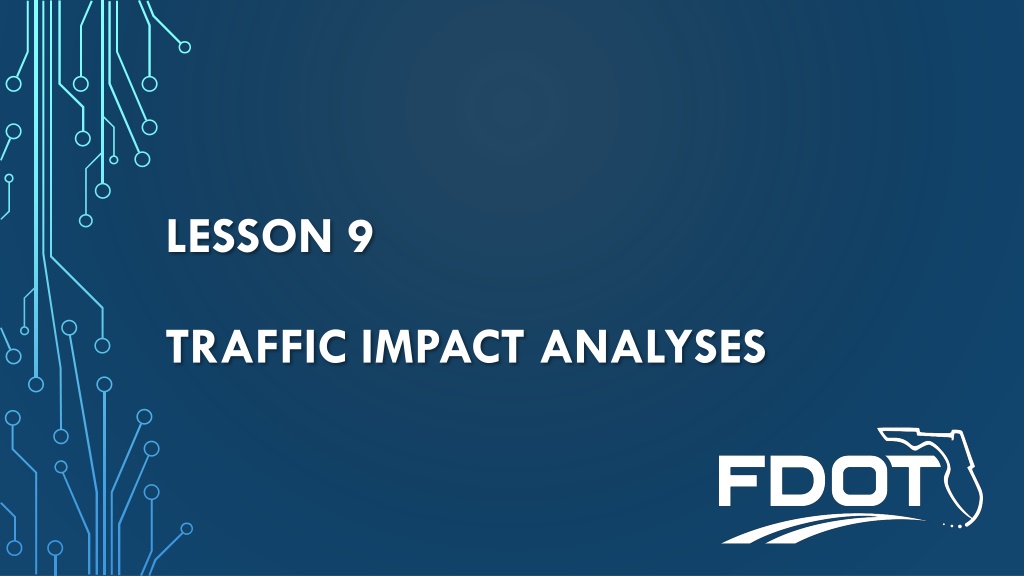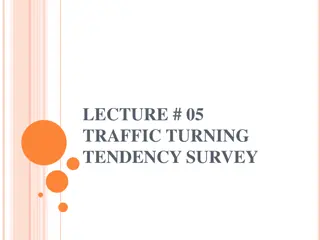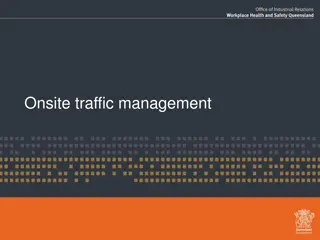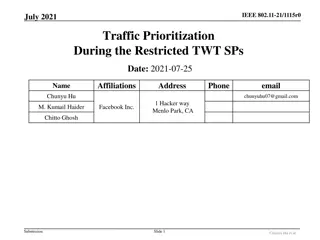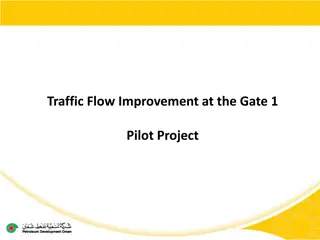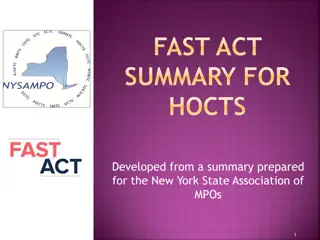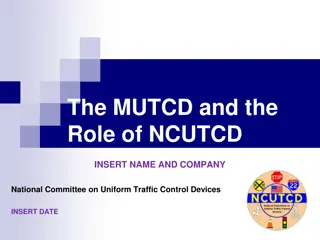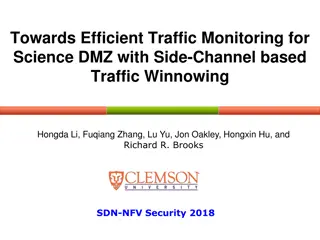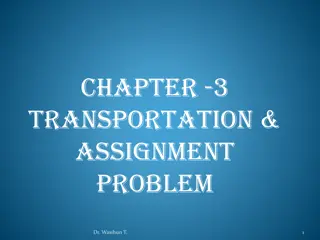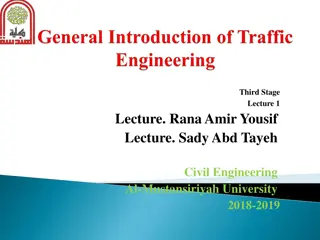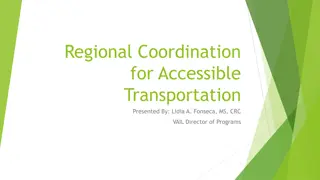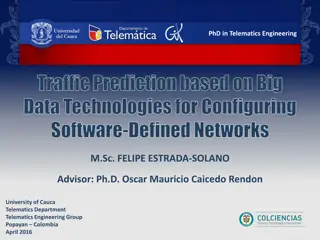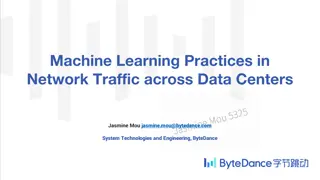Understanding the Importance of Traffic Impact Analysis in Transportation Planning
Traffic impact analysis plays a crucial role in evaluating the effects of proposed developments on transportation infrastructure. This analysis helps in identifying the potential burden on the community's transportation network and ensures that growth is managed effectively. By examining short- and long-range mitigation strategies, such as access improvements and multi-modal commitments, traffic impact analysis aids in facilitating planning efforts and maintaining the performance of transportation systems.
- Traffic impact analysis
- Transportation planning
- Growth management
- Mitigation strategies
- Infrastructure evaluation
Download Presentation

Please find below an Image/Link to download the presentation.
The content on the website is provided AS IS for your information and personal use only. It may not be sold, licensed, or shared on other websites without obtaining consent from the author. Download presentation by click this link. If you encounter any issues during the download, it is possible that the publisher has removed the file from their server.
E N D
Presentation Transcript
LESSON 9 TRAFFIC IMPACT ANALYSES 1
PART A TRAFFIC IMPACT ANALYSIS OVERVIEW FSUTMS COMPREHENSIVE MODELING WORKSHOP 2
LESSON GOALS In this lesson we will discuss: Overview of traffic impact analysis Travel demand modeling for major developments and other traffic impact analyses Requirements for defining the area of influence or traffic impact area Select-link and select-zone analysis Model volumes FSUTMS COMPREHENSIVE MODELING WORKSHOP 3
OUTLINE Traffic Impact Analysis: What is it and why do it? Internal vs. external project trips Models for traffic impact analysis FSUTMS vs. Institute of Transportation Engineers (ITE) FSUTMS COMPREHENSIVE MODELING WORKSHOP 4
WHAT IS TRAFFIC IMPACT ANALYSIS Traffic impact analysis is used to measure the magnitude of a proposed development s anticipated burden to the community s transportation infrastructure Traffic impacts are typically measured in relation to level-of-service (LOS) Many cities and counties in Florida have recently established multi- modal transportation districts where roadway LOS is no longer a priority FSUTMS COMPREHENSIVE MODELING WORKSHOP 5
WHY PERFORM TRAFFIC IMPACT ANALYSIS? Facilitate planning efforts Ensure that growth does not overcome the ability of the transportation network to serve such growth New development can severely impair the performance of the transportation network Need to address planning considerations for both short- and long-range traffic mitigation strategies FSUTMS COMPREHENSIVE MODELING WORKSHOP 6
WHY PERFORM TRAFFIC IMPACT ANALYSIS? (CONT D) Short-Range Mitigation Strategies: Access Improvements Intersection Improvements Signal Improvements Multi-modal transportation commitments FSUTMS COMPREHENSIVE MODELING WORKSHOP 7
WHY PERFORM TRAFFIC IMPACT ANALYSIS? (CONT D) Long Range Mitigation Strategies: Off-site Improvements Traffic Impact Assessment Processes: Proportionate Share Concurrency Major Developments (Developments of Regional Impact (DRIs)) 8
WHY PERFORM TRAFFIC IMPACT ANALYSIS? (CONT D) Proportionate Share: Formulaic assessment of a major development s impact to the region s infrastructure to identify amount to mitigate the impact Proportionate Fair Share is a separate designation applicable to sub- developments that fail concurrency: Permits development to continue by allowing developers to offset development impact by contributing to expanding the affected infrastructure All local jurisdictions were required to adopt ordinances for the Proportionate Fair Share process by December 1, 2006 FSUTMS COMPREHENSIVE MODELING WORKSHOP 9
WHY PERFORM TRAFFIC IMPACT ANALYSIS? (CONT D) Concurrency: Became law in Florida in 1985 through F.S. 163.3180 Ensures that there is sufficient capacity to meet new growth Local governments must define adequate levels-of-service A permit cannot be issued if new development fails to meet concurrency Exceptions may apply in the form of Transportation Concurrency Exemption Areas, Proportionate Fair Share, and Multi-Modal Transportation Districts FSUTMS COMPREHENSIVE MODELING WORKSHOP 10
WHY PERFORM TRAFFIC IMPACT ANALYSIS? (CONT D) Major Developments: Developments surpassing a certain threshold of intensity are considered to have a regional impact Thresholds for residences are established based on county population. Thresholds for other land uses differ based on land use Effective April 9, 2018, the statutory provisions in Chapter 380, related DRIs were amended to eliminate the review process regarding changes to existing DRIs This change is in addition to statutory changes in 2015 and 2016 that eliminated the DRI review process for new proposed developments that exceed the DRI thresholds and are not exempt from review FSUTMS COMPREHENSIVE MODELING WORKSHOP 11
INTERNAL vs. EXTERNAL PROJECT TRIPS Internal Project Trips: Have their origin and destination within zones representing the project site Stay on facilities within and designed to serve the internal needs of the project site Generally referred to in the analysis as internal capture Should be calculated using ITE methodologies Are not the focus of modeling efforts to analyze traffic impact FSUTMS COMPREHENSIVE MODELING WORKSHOP 12
INTERNAL vs. EXTERNAL PROJECT TRIPS (CONT D) External Project Trips: Have one trip end in zone representing the project site and one trip end in zone outside the project site Travel on facilities that serve travel needs outside of the project area Can be identified by using a cordon line to select roadway segments/highway links that enter and leave the project site Modeling efforts to analyze traffic impact should focus on replicating ITE external project trips FSUTMS COMPREHENSIVE MODELING WORKSHOP 13
SITE IMPACT CORDON LINES Imaginary cordon around the site intersecting all facilities entering and leaving the site helps identify external trips Sum number of trips generated by the project site traveling on each link intersecting the cordon in order to arrive at total external project trips for the site The dashed circle on the next slide represents a cordon around a proposed development site, the arrows point to the links that intersect the cordon FSUTMS COMPREHENSIVE MODELING WORKSHOP 14
SITE IMPACT CORDON LINES (CONTD) Development Zones FSUTMS COMPREHENSIVE MODELING WORKSHOP 15
WHY USE MODELS FOR TRAFFIC IMPACT ANALYSIS? Models place the impacts of proposed developments in the context of an integrated transportation network Traffic from the proposed site can be measured against traffic generated from developments all throughout the region covered by the model The distribution and assignment of trips are carried out on an integrated model network, minimizing bias that results from manual procedures FSUTMS COMPREHENSIVE MODELING WORKSHOP 16
WHY USE MODELS FOR TRAFFIC IMPACT ANALYSIS? (CONT D) Reduces the level of effort involved in tracing the site s impact beyond the immediate area of the site Typically, models represent MPO-adopted datasets reflecting expected levels of regional growth and include planned improvements to the transportation network Models provide the analyst with a grounded source of assumptions on the levels of growth occurring in the study area FSUTMS COMPREHENSIVE MODELING WORKSHOP 17
DIFFERENCES BETWEEN ITE AND FSUTMS There are significant differences in the methodologies proposed by ITE for calculating trips and those used with FSUTMS models FSUTMS COMPREHENSIVE MODELING WORKSHOP 18
DIFFERENCES BETWEEN ITE AND FSUTMS (CONT D) ITE Manual Trip Calculations: ITE Trip Generation, 10th Edition Trip rates are provided for daily and various peak hour conditions Simple calculations may be done with a calculator or pen and paper, more complex projects may use a spreadsheet or Trip Generation software Internal capture is assessed as the interaction of the various land uses being considered for a project FSUTMS COMPREHENSIVE MODELING WORKSHOP 19
DIFFERENCES BETWEEN ITE AND FSUTMS (CONT D) ITE (Cont d) Trip Rates: Rates are in vehicle trips. Trip rates are derived from counting vehicles entering and leaving a particular land use. Numerous land use types are surveyed so that average trip rates and regression equations can be developed. Rates are dependent on the physical characteristics of the development: Dwelling units for residences Square footage for employers Specialized land uses may use different variables (e.g., acreage) FSUTMS COMPREHENSIVE MODELING WORKSHOP 20
DIFFERENCES BETWEEN ITE AND FSUTMS (CONT D) ITE (Cont d) Land Use: Dozens of distinct land use categories Land uses organized according to intensity and function Trip Generation, Internal Capture, Pass-by Software (TIPS), or Trip Generation by Microtrans: Software developed to do ITE trip generation automatically Allows the user to input a variety of land uses at varying intensities to simulate the proposed development characteristics Calculates trip generation and internal capture based on ITE Trip Generation Handbook techniques FSUTMS COMPREHENSIVE MODELING WORKSHOP 21
DIFFERENCES BETWEEN ITE AND FSUTMS (CONT D) FSUTMS Automated Trip Calculations: Trip generation, distribution, and assignment are conducted automatically using modeling software Models use a set of specialized mathematical models for trip calculation: Generation Cross-Tabulation or User-Specified Trip Rates Distribution Gravity Model Assignment Equilibrium Algorithm The studied site is impacted by the trip-making behavior of all other land uses in the model FSUTMS COMPREHENSIVE MODELING WORKSHOP 22
DIFFERENCES BETWEEN ITE AND FSUTMS (CONT D) FSUTMS (Cont d) Trip Rates: Rates are in person trips Trip rates are derived most commonly from household travel surveys and personal trip diaries Trip rates are aggregated based on survey results into various socioeconomic categories Socioeconomic data used in trip generation model include: Population, dwelling units, vacancy rates, lifestyle cohorts Income, automobile ownership Employment, schools, unique (special) land uses FSUTMS COMPREHENSIVE MODELING WORKSHOP 23
DIFFERENCES BETWEEN ITE AND FSUTMS (CONT D) FSUTMS (Cont d) Land Use: Typically, only three production land uses and four attraction land uses: Production - single-family dwelling, multi-family dwelling, hotel-motel units Attraction - industrial employment, service employment, commercial employment, school enrollment Land uses are aggregated and combined into zones Aggregated zone structure and abstracted access system (centroid connectors) limits the usefulness in using models for calculating internal capture FSUTMS COMPREHENSIVE MODELING WORKSHOP 24
DIFFERENT FSUTMS METHODS There are two general methodologies for using an FSUTMS model for a traffic impact analysis: Special Generator Method Link Volume Factor Method Each approach has pros and cons Each requires a combination of ITE and FSUTMS methodologies in order to conduct a traffic impact analysis FSUTMS COMPREHENSIVE MODELING WORKSHOP 25
SPECIAL GENERATOR METHOD Reasons to Use the Special Generator Method: Simplifies the analysis process since the appropriate number of ITE trips interact dynamically with the background traffic generated by the model Since special generators are a direct input for the number of trips, there is no need for the analyst to develop socioeconomic data to represent the site These trips will still need to be split into the appropriate trip purpose categories by the analyst FSUTMS COMPREHENSIVE MODELING WORKSHOP 26
LINK VOLUME FACTOR METHOD Reasons to Use the Link Volume Factor Method: Trip generation will be consistent between all zones throughout the model Eliminates any biases in trip distribution Sites being studied will produce or attract a similar amount of trips as similar land uses of similar intensity in the modeled study area Removes the need to conduct iterative adjustments to the model s trip generation, saving time and effort with larger models FSUTMS COMPREHENSIVE MODELING WORKSHOP 27
NET IMPACT METHOD Not acceptable for traffic impact analysis in Florida Consists of comparing two separate model runs, one with the proposed project and one without to derive net impact Because of diversion due to capacity constraints during the assignment, net impact is usually negligible FSUTMS COMPREHENSIVE MODELING WORKSHOP 28
NET IMPACT METHOD (CONTD) FSUTMS Total Trips (With Development) Net Impact??? 10,000 50,000 45,000 10,000 50,000 - 48,000 2,000 45,000 - 48,000 -3,000 FSUTMS Total Trips (Without Development) or 0 48,000 48,000 FSUTMS COMPREHENSIVE MODELING WORKSHOP 29
QUIZ #12 Which method is not acceptable for use in conducting traffic impact analyses in Florida? A. Special generator method B. Link volume factor method C. Net impact method D. None of the above FSUTMS COMPREHENSIVE MODELING WORKSHOP 30
QUIZ #12 ANSWERS Which method is not acceptable for use in conducting traffic impact analyses in Florida? A. Special generator method B. Link volume factor method C. Net impact method D. None of the above FSUTMS COMPREHENSIVE MODELING WORKSHOP 31
END OF LESSON 9, PART A PLEASE PROCEED TO GUIDED EXERCISE 42 FSUTMS COMPREHENSIVE MODELING WORKSHOP 32
PART B NEW DEVELOPMENT MODELING WITH FSUTMS FSUTMS COMPREHENSIVE MODELING WORKSHOP 33
OUTLINE Development Modeling with FSUTMS: Special generator method Link volume factor method Net impact method (not allowed) Land use conversion rates Other considerations FSUTMS COMPREHENSIVE MODELING WORKSHOP 34
SPECIAL GENERATOR METHOD Method: Calculate ITE external trip generation off-model Input trips into special generator file for zone(s) corresponding to development site Allocate trip percentages into the trip purpose categories in the special generator file Factor ITE vehicle trips to person trips Run the model Compare ITE trips to loaded network link volumes corresponding to links at a site cordon FSUTMS COMPREHENSIVE MODELING WORKSHOP 35
SPECIAL GENERATOR METHOD (CONTD) Method: (Cont d) Adjust trips in special generator file as needed and rerun the model: Increase the number of trips if the model trip volumes at the site cordon are lower than the ITE trips Decrease the number of trips if the model trip volumes at the site cordon are higher than the ITE trips This may be an iterative process Once model volumes are greater than or equal to ITE trips, conduct a select-zone analysis of the zone(s) corresponding to the development site to trace trips throughout the network Take results from the model and continue with the analysis using established practices FSUTMS COMPREHENSIVE MODELING WORKSHOP 36
SPECIAL GENERATOR METHOD (CONTD) Caveats: Will bias the trip distribution due to uneven nature of FSUTMS and ITE trip generation methods Sites being studied may produce or attract significantly more or fewer trips than similar land uses of similar intensity in the modeled study area Larger models take more time to run this can make iterating special generator trips more difficult and time consuming FSUTMS COMPREHENSIVE MODELING WORKSHOP 37
SPECIAL GENERATOR METHOD (CONTD) Example: A developer is planning to build a large retail super store named Big Box This store will be located near an existing competitor named Large Lot Both stores have similar characteristics They each have 400 employees Big Box Large Lot FSUTMS COMPREHENSIVE MODELING WORKSHOP 38
SPECIAL GENERATOR METHOD (CONTD) Example: (Cont d) Large Lot is already present in the model, so Big Box would need to be added If Big Box were coded into the model as a traditional FSUTMS land use, the corresponding TAZ would possess 400 commercial employees in the zone data file As a result, they would generate approximately the same number of trips FSUTMS COMPREHENSIVE MODELING WORKSHOP 39
SPECIAL GENERATOR METHOD (CONTD) Example: (Cont d) If, on the other hand, Big Box were coded using the special generator method, Big Box would have no data in the zone data file Instead, the special generator file would be run iteratively until we reached the ITE vehicle trip value for this land use: 10,519 Even though both sites have similar characteristics, Big Box becomes much more attractive than Large Lot FSUTMS COMPREHENSIVE MODELING WORKSHOP 40
LINK VOLUME FACTOR METHOD Method: Estimate socioeconomic data based on developer specifications of the project Use rates for persons per dwelling units and employees per 1,000 sq ft that are acceptable to reviewers Input socioeconomic data representing the project into the zonal data fill Run the model Conduct a selected zone analysis of the zone(s) corresponding to the site and save the resulting data to the loaded network these are the project trips FSUTMS COMPREHENSIVE MODELING WORKSHOP 41
LINK VOLUME FACTOR METHOD (CONTD) Method: (Cont d) Identify an external cordon around the development site Any project trip that passes through a link that intersects with the external cordon is an external project trip Calculate the total number of external project trips Calculate the percent distribution of external project trips by dividing the number of project trips on each link of the network by the total number of external project trips Use an off-model technique to calculate the total number of ITE external project trips for the site FSUTMS COMPREHENSIVE MODELING WORKSHOP 42
LINK VOLUME FACTOR METHOD (CONTD) Method: (Cont d) Factor the total number of ITE external project trips by the link distribution percentages calculated earlier for each link in the loaded network Take the results from the model and continue with the analysis using established practices FSUTMS COMPREHENSIVE MODELING WORKSHOP 43
LINK VOLUME FACTOR METHOD (CONTD) Caveats: The final project trips after factoring the ITE trips by link distribution percentages are not consistent with the modeled trip generation; resulting trip tables do not match ITE trips Modeled capacity constraints may not be consistent with ITE project trips this means that project traffic may not be accurately impacted by congestion during highway assignment FSUTMS COMPREHENSIVE MODELING WORKSHOP 44
LINK VOLUME FACTOR METHOD (CONTD) Caveats: (Cont d) Socioeconomic data must be estimated by applying rates to data typically provided by a developer These estimates may not accurately reflect the real development pattern of the site Also, developer-provided data are typically not complete from a modeling perspective, requiring the analyst to make assumptions based on existing model data FSUTMS COMPREHENSIVE MODELING WORKSHOP 45
LINK VOLUME FACTOR METHOD (CONTD) Example: A developer is planning to build a large retail super store named Big Box This store will be located near an existing competitor named Large Lot Both stores have similar characteristics They each have 400 employees Big Box Large Lot FSUTMS COMPREHENSIVE MODELING WORKSHOP 46
LINK VOLUME FACTOR METHOD (CONTD) Example: (Cont d) This screenshot depicts the distribution pattern of the Big Box trips when they are analyzed using the Link Volume Factor Method Note the encircled areas FSUTMS COMPREHENSIVE MODELING WORKSHOP 47
LINK VOLUME FACTOR METHOD (CONTD) Example: (Cont d) This screenshot depicts the distribution pattern of the Big Box trips when they are analyzed using the Special Generator Method Note the encircled areas compared to the previous slide NOTE: These slides are not representative of the different methodologies and their distribution patterns. No conclusions can be drawn based on these slides as to which method best serves one s needs FSUTMS COMPREHENSIVE MODELING WORKSHOP 48
COMPUTING A LINK VOLUME FACTOR In order to calculate a link volume factor, it is necessary to first conduct a selected zone analysis using either a path file generated by the model or by modifying the assignment script Once selected zone volumes for the site have been saved to the loaded network it will be necessary to divide the selected zone volume by the total external volume for the site FSUTMS COMPREHENSIVE MODELING WORKSHOP 49
COMPUTING A LINK VOLUME FACTOR Use the following formula to calculate the link volume factor per link using the Link Attribute Calculator in Cube ???????? ???? ?????? ????? ???????? ??????? ????? ???? ?????? ?????? = Once the link volume factor has been calculated, it is then possible to factor the ITE trip generation volume for the site FSUTMS COMPREHENSIVE MODELING WORKSHOP 50
